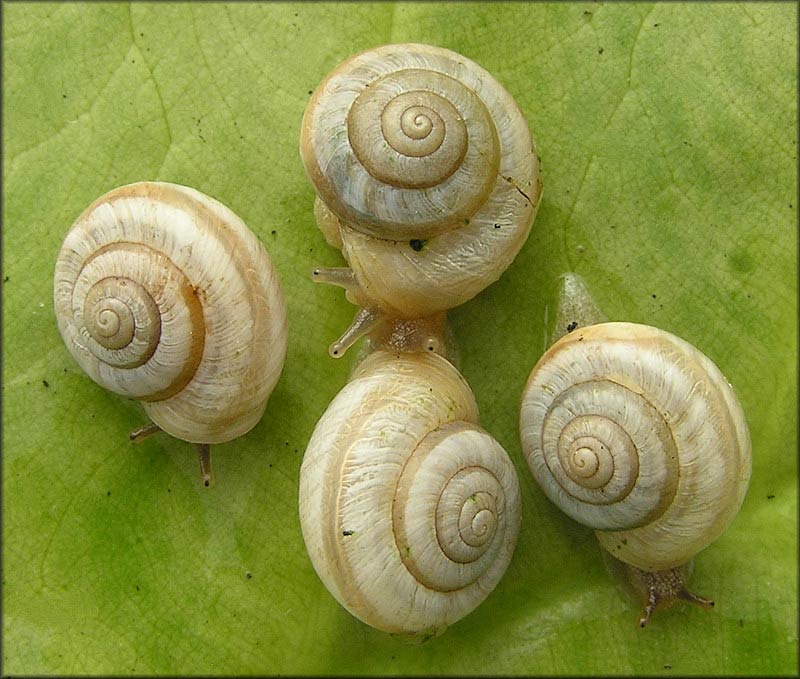Praticolella griseola
|
Praticolella griseola. (Photo: © B. Frank, Jacksonville) |
|
Praticolella griseola. (Photo: © B. Frank, Jacksonville) |
|
Praticolella griseola. (Photo: © B. Frank, Jacksonville) |
Family
Polygyridae
Species
Praticolella griseola (Pfeiffer, 1841)
Common name
Vagrant scrubsnail, Vera cruz shrubsnail
Description
The tan to brown-gray, umbilicate (possess a navel-like opening), flattened shellShell:
A hard, inflexible, calcareous or chitinous structure that vary in size and may either completely encasing the animal, covering some part of it or be internal.
of this species varies in heightHeight:
The height of the shell is a measure of the distance between the apex and the most basal part of the shell OR the measurement taken from the apex of the shell to the base, when measured parallel to the axis of the shell.
6-11 mm and diameter 8-13.7 mm. There are 4-5 1/2 whorlsWhorls:
Pleural of whorl. A whorl is a complete spiral turn/growth of the shell of a mollusc. The whorls are counted from the apex outwards.
. The shellShell:
A hard, inflexible, calcareous or chitinous structure that vary in size and may either completely encasing the animal, covering some part of it or be internal.
may be glossy in color with faint oblique striationsStriations:
Having a series of stripes, grooves or lines.
. There are several pale tawny stripes that have a white color on each margin. The spireSpire:
All the coils (whorls) of a shell above the body whorl.
is short. The umbilicusUmbilicus:
A navel-like indentation or depression in the center of the shell. It may be described as open (inside of columella visible), partially closed (partly covered by base of aperture) or completely closed (not visible). The width of the umbilicus is a measure of its greatest diameter.
(navel) is very narrow and the apertureAperture:
The major opening of a shell that the body of the animal may be retracted.
(mouth) lunate. The peristomePeristome:
Margin of the aperture of a snail's shell. This region may be thickened in mature animals.
(edge of the mouth) is simple, white and a little reflected, with the columellar margin slightly extended.
Native range
Northern and Central America
Distribution
North America:
- U.S.: Florida, Texas
Central America: Mexico
Caribbean: Cuba, Dominican Republic, Jamaica
Ecology
This species has been intercepted on shipments from the Dominican Republic to the U.S on the leguminous plant, guar gum (Cyamopsis tetragonolobus) .
Synonyms
- Bradybaena pisum Beck, 1837, Index, p. 18, not described, Pfeiffer, 1. c. in synonymn.
- Helix griseola Pfeiffer, 1841, Symbolae HIst. Hel., 1: 41, Conchyl. Cab., Helix, p.342, pl. 60, figs. 17, 18; Monogr. Hel. Viv., 1: 337.
- Helix cicercula Ferussac, in coll., = griseola according to Pfeiffer, Monogr. Hel. Viv., 1: 337.
- Helix albocincta A. Binney, 1851 Terr. Moll., 1: 109, 128, name only.
- H. albolineata "Binney", Gould 1857, Terr. Moll, 3: 34 (referring to Terr. Moll. 3, pl. 49, fig. 2), as var of berlandieriana.
- H. albo-zonata A. Binney, 1857, Terr. Moll., 3, pl. 49, fig. 2
- Dorcasia griseola Pfeiffer, W. G. Binney, 1878, Terr. Moll., 5: 348, fig. 231(jaw), pl. vii, fig. v (teeth).
- H. berlandieriana var. griseola Pfeiffer, Von Martensis, 1892., Biol. Centr.-Amer., Moll., p. 140, pl. 7, figs. 15-17.
References
Abbott 1989; Perez and Cordeiro 2008; Pilsbry 1940; Rosenberg and Muratov 2006




